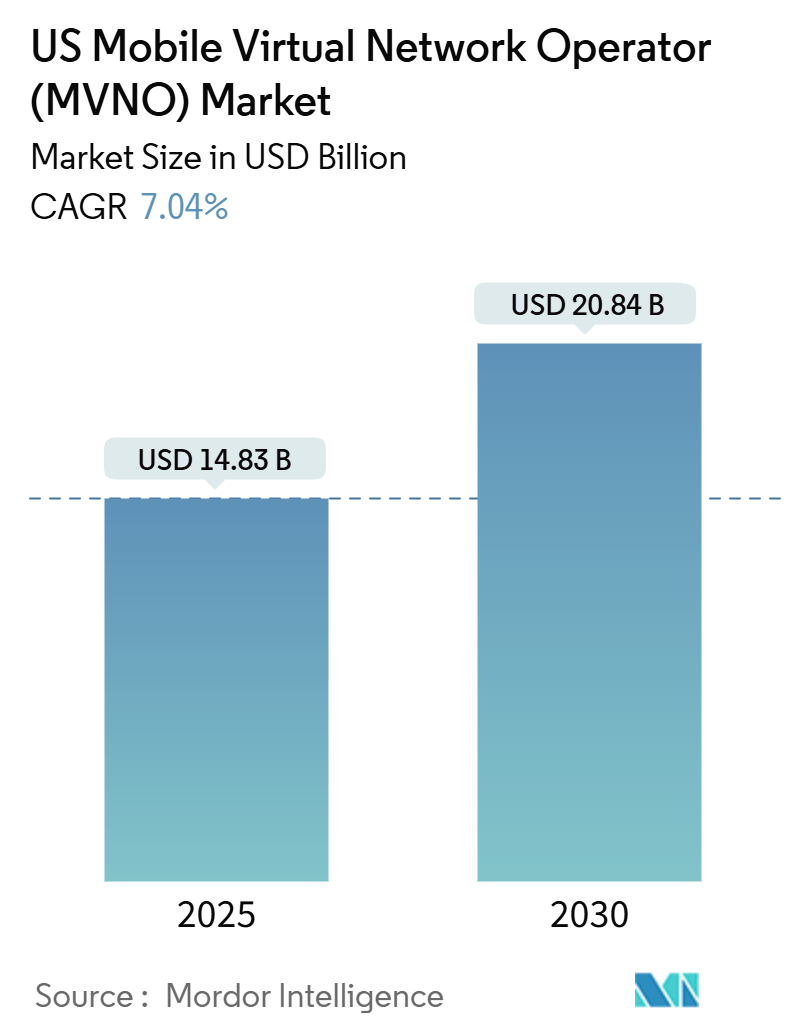
| Study Period | 2019 - 2030 |
| Base Year For Estimation | 2024 |
| Forecast Data Period | 2025 - 2030 |
| Market Size (2025) | USD 14.83 Billion |
| Market Size (2030) | USD 20.84 Billion |
| CAGR (2025 - 2030) | 7.04 % |
| Market Concentration | Medium |
Major Players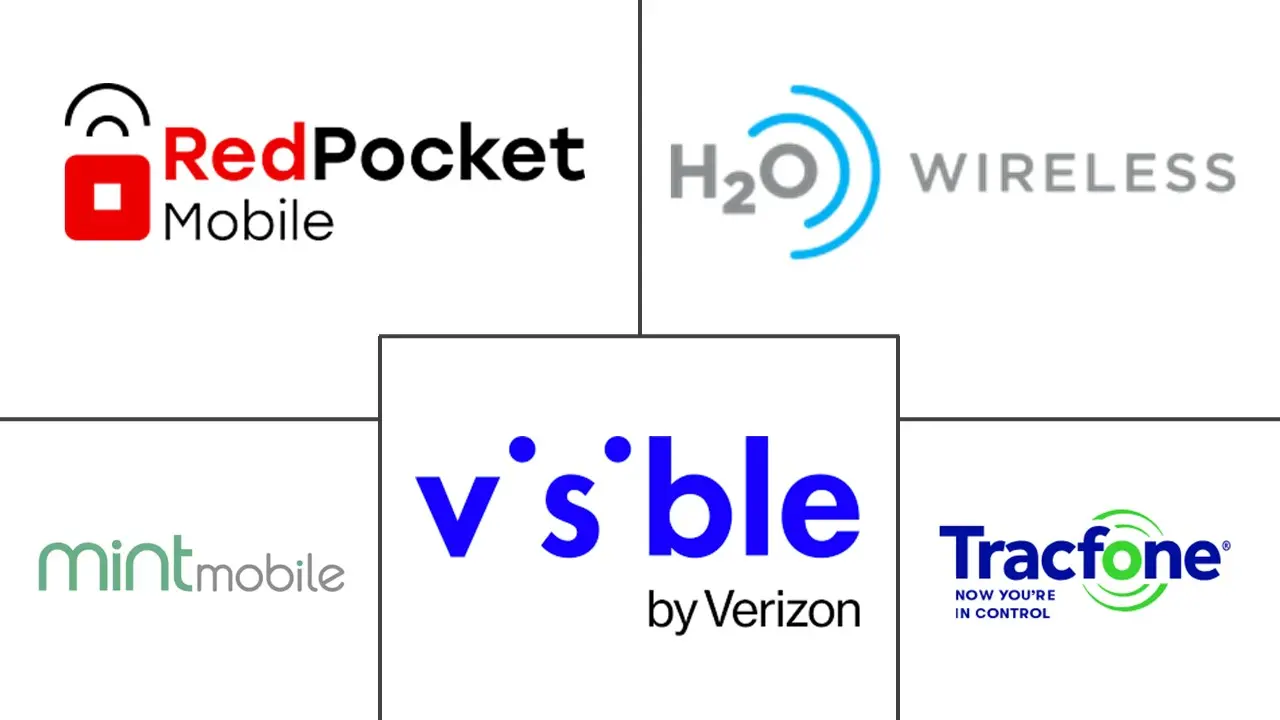
*Disclaimer: Major Players sorted in no particular order |
US Mobile Virtual Network Operator (MVNO) Market Analysis
The US Mobile Virtual Network Operator Market size is estimated at USD 14.83 billion in 2025, and is expected to reach USD 20.84 billion by 2030, at a CAGR of 7.04% during the forecast period (2025-2030).
- The US MVNO market is expected to expand rapidly during the forecast period due to the rise in mobile device adoption, the rising need for affordable mobile services, accelerated expansion of 5G by major MNOs, growing partnerships among MNOs and MVNOs, and the rising demand for cost-effective, high-speed internet access across businesses and consumers.
- Network speed enhancements and the proliferation of high-tech gadgets have fueled a surge in data applications nationwide, notably video streaming and internet surfing. The MVNO model boasts advantages such as time and cost efficiency and substantial investments to bolster mobile broadband (MBB) connections and expand network coverage.
- As a result, increased users will likely gravitate towards the model's affordable internet and phone services, propelling its growth. Furthermore, MVNOs amplify network usage and empower Mobile Network Operators (MNOs) to establish their own MVNOs, unveiling vast market opportunities within the country.
- With inflation and rising living expenses, individuals are opting for MVNOs as a strategic approach to managing their budgets. These affordable solutions appeal to price-sensitive consumers, including lower-income households, who are navigating the challenges of persistent inflationary pressures. As a result, MVNOs are gaining traction by addressing the growing need for economical alternatives in the mobile services market.
- The US MVNO market is characterized by significant fragmentation, which prevents the establishment of dominant players and fosters intense competition. Each MVNO strives to differentiate itself by focusing on competitive pricing, unique features, or targeting specific customer segments. However, the lack of market consolidation restricts their ability to achieve economies of scale, resulting in compressed profit margins and weakened bargaining power with network operators.
- This fragmented structure also limits the capacity of individual MVNOs to allocate resources toward critical areas such as brand development, technological advancements, and customer retention strategies. Consequently, these challenges collectively hinder the long-term growth prospects and competitiveness of MVNOs in the market.
- US MVNOs encounter both challenges and opportunities during economic recessions as they cater to a cost-sensitive customer base. U.S. consumers typically reduce discretionary spending, including telecom expenses, during such periods. This behavior often drives a shift from expensive MNO plans to the more economical options MVNOs offer. Providers like Mint Mobile, TracFone, and Boost Mobile are well-positioned to attract these budget-conscious customers with their prepaid, no-contract plans.
US Mobile Virtual Network Operator (MVNO) Market Trends
Service Operators to be the Fastest Growing Operating Model
Shift towards data-centric services is driving the market demand:
- Service operator MVNOs are shifting their focus from traditional voice and text services to data-centric offerings. With consumers increasingly valuing mobile data for activities like streaming, gaming, and social media, MVNOs are enhancing their data plans and features to meet these demands.
- In July 2024, Mediacom Communications launched mobile services in an MVNO agreement with Verizon, joining a rising number of US cable operators in the mobile market. As the fifth-largest cable operator in the US, Mediacom introduces two mobile plans, both of which require a subscription to its broadband service.
Adoption of 5G technology to drive market demand:
- The rollout of 5G networks is creating new opportunities for service operator MVNOs. By offering 5G plans, these MVNOs can attract tech-savvy consumers who are looking for faster speeds and improved connectivity. This trend is expected to drive growth as more consumers upgrade their devices to take advantage of 5G capabilities. According to an Ericsson survey published in June 2024, North America is expected to have 432.91 million 5G mobile subscriptions by 2029.
- In November 2024, Boost Mobile transitioned from its status as a mobile virtual network operator (MVNO) to position itself as the fourth-largest carrier in the US, intensifying its competition with giants Verizon, AT&T, and T-Mobile.
- In the United States, MVNO service providers are experiencing significant growth by focusing on delivering simplified services, catering to niche customer segments, adopting advanced digital transformation strategies, and leveraging the widespread availability of 5G technology.
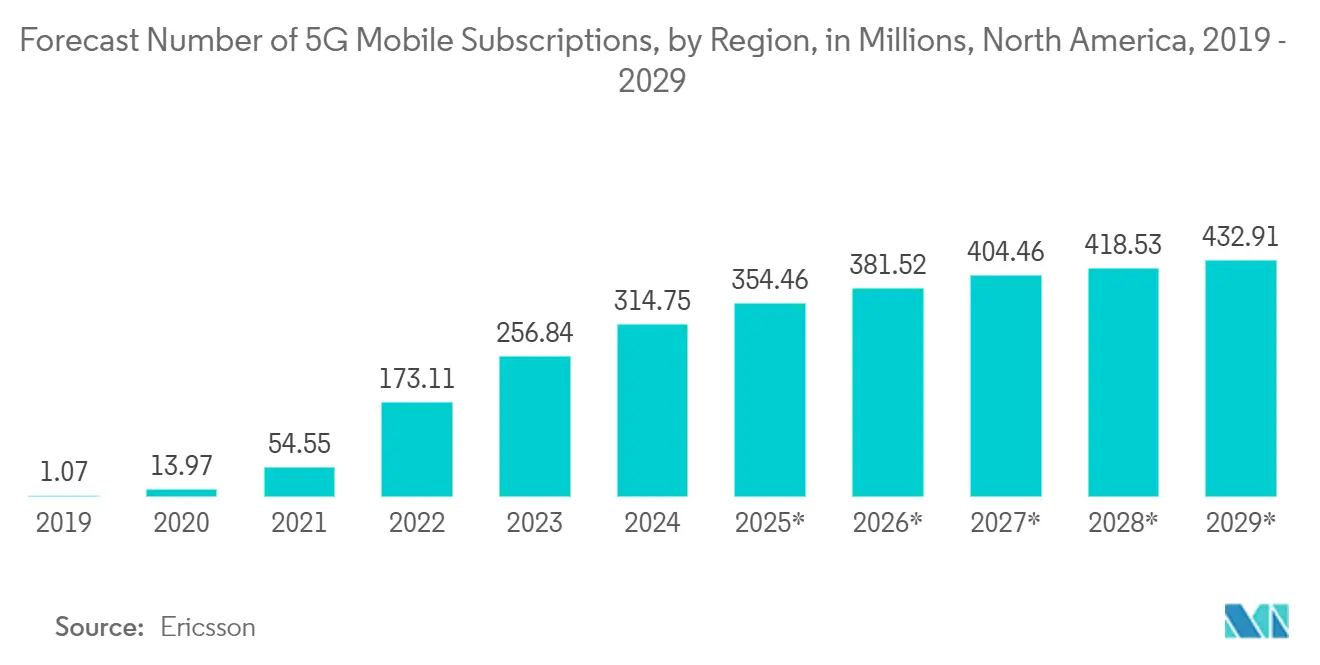
Consumer Segment to be the Largest End User Type
- In the United States, multiple factors are contributing to the expansion of the consumer segment within the MVNO market. These include increasing price sensitivity among consumers, a growing reliance on mobile data for daily activities, the widespread adoption of applications and online management tools, and a rising preference for flexibility in mobile service offerings, among other drivers.
- One of the main factors driving the growth of MVNOs in the United States is the increasing demand for low-cost mobile services. Many consumers in the United States are price-sensitive and are looking for affordable alternatives to traditional mobile operators. MVNOs have responded to this demand by offering competitive pricing and flexible plans that cater to different segments of the market.
- Mobile Virtual Network Operators (MVNOs) in the United States are adopting competitive pricing strategies to attract cost-conscious consumers. These consumers prioritize affordability and flexibility and seek alternatives to traditional long-term contract commitments.
- The availability of no-contract, pay-as-you-go plans allows consumers to tailor their mobile service options. This approach ensures that their specific requirements and usage patterns are met, further appealing to this growing consumer segment in the United States.
- Mobile Virtual Network Operators (MVNOs) offer flexible options that empower consumers to personalize their mobile service plans. Customers can select specific data limits, voice minutes, and text messaging options tailored to their unique needs and preferences.
- The adoption of app-based management solutions provides users with the ability to actively monitor and modify their plans in real time. This functionality enhances user autonomy and satisfaction by offering greater control over their mobile service usage.
- According to the Federal Communications Commission, in 2023, mobile cellular subscriptions in the United States reached nearly 386 million, reflecting a 3.6 percent growth compared to the previous year. This growth elevated US mobile penetration to 112 subscriptions per 100 inhabitants.
- Rising data consumption among US consumers, combined with rapid advancements in digital transformation, the rollout of 5G technology, and increasing demand for tailored services, is significantly driving the expansion of the MVNO market.
- According to GSMA, in 2022, 5G connections surged to 43 percent of all mobile connections in the United States, a significant jump from 15 percent in 2021. Meanwhile, 4G connections held steady at 56 percent. Projections indicate that by 2030, 5G will dominate with a commanding 95 percent share of all United States connections. These factors are reshaping consumer preferences and creating new opportunities for market players to innovate and capture a larger market share.
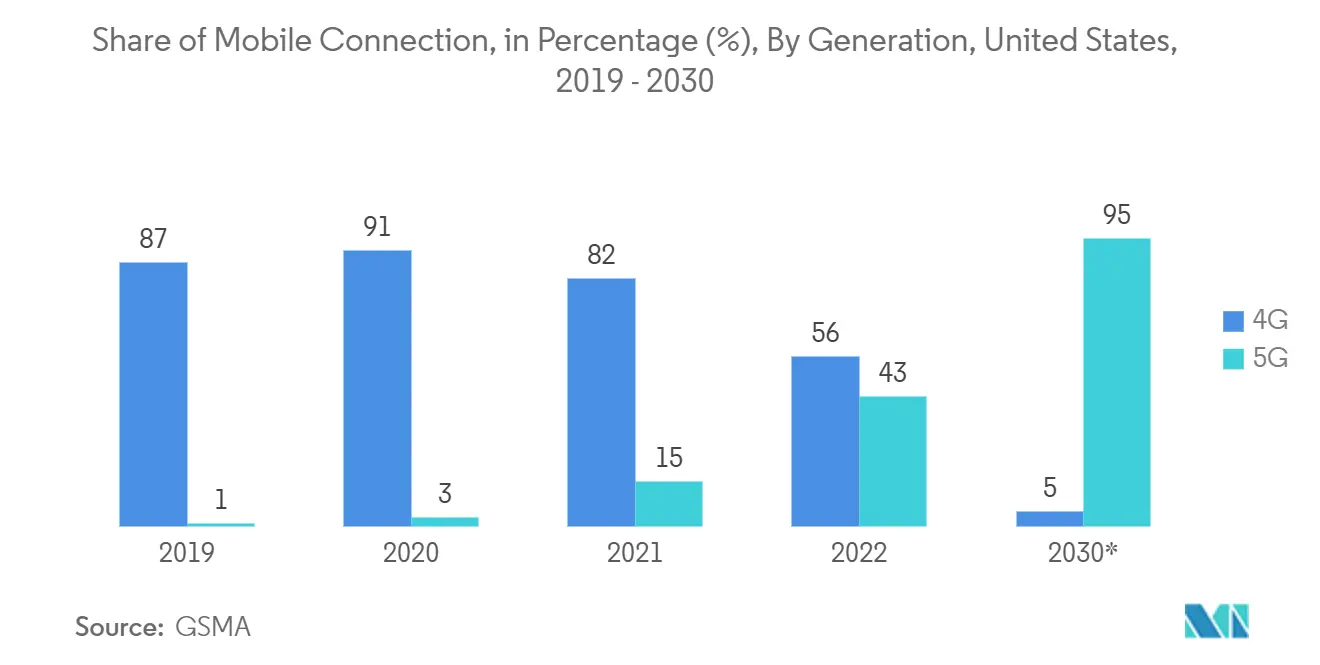
US Mobile Virtual Network Operator Industry Overview
The US MVNO market is semi fragmented, While several large multinational companies dominate specific high-value segments, regional and niche players contribute to the overall competition, making the market highly diverse.
Some of the major players in the market are H2O Wireless (Locus Telecommunications, LLC), Mint Mobile, LLC. (T-Mobile US, Inc.), RedPocket Mobile, TracFone Wireless, Inc.(Verizon Communications Inc.), and Visible (Verizon Communications). Players in the market are adopting strategies such as partnerships and acquisitions to enhance their product offerings and gain sustainable competitive advantage.
US Mobile Virtual Network Operator (MVNO) Market Leaders
-
H2O Wireless (Locus Telecommunications, LLC)
-
Mint Mobile, LLC. (T-Mobile US, Inc.)
-
RedPocket Mobile
-
TracFone Wireless, Inc.(Verizon Communications Inc.)
-
Visible (Verizon Communications)
- *Disclaimer: Major Players sorted in no particular order
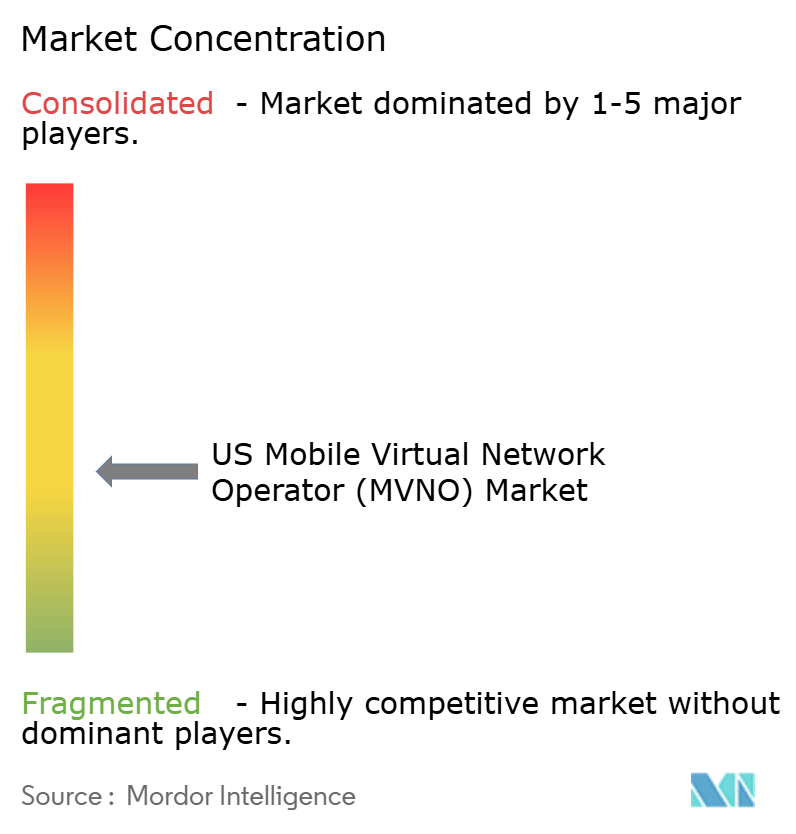
US Mobile Virtual Network Operator (MVNO) Market News
- October 2024: Tracfone, a part of Verizon's Value portfolio, has announced improvements to its Unlimited Talk & Text plans, doubling the data allocation at no additional cost. These enhancements provide greater value than competitors and ensure customers pay only for their actual usage, eliminating unexpected overage charges. To enhance flexibility, Tracfone has introduced new plan durations, including 60-, 90-, 180-, and 365-day options alongside the existing 30-day plan, among other features.
- April 2024: Visible expanded its payment options for both its Visible and Visible+ wireless plans. The introduction of new annual plans not only diversifies payment methods but also enhances savings for customers. These new offerings, complementing the existing month-to-month options, emphasize flexibility and value.
US Mobile Virtual Network Operator Industry Segmentation
The United States MVNO market is defined based on the revenues generated from the MVNO operating models offered by the various players operating in the market across end-users. The analysis is based on the market insights captured through secondary research and the primaries. The market also covers the major factors impacting the growth of the market in terms of drivers and restraints.
The US MVNO Market is segmented by operating model (reseller, service operator, full MVNO, and other models), and by end user type (business and consumer). The market sizes and forecasts are provided in terms of value (USD) for all the above segments.
| Overall US MVNO Market | Covering Insights on Overall Subscriber Base and ARPU |
| By Operating Model (Market Size Estimates, Forecasts, Trends and Other Market Dynamics) | Reseller |
| Service Operator | |
| Full MVNO | |
| Other Models | |
| By End-user Type (Market Size Estimates, Forecasts, Trends and Other Market Dynamics) | Business |
| Consumer |
US Mobile Virtual Network Operator (MVNO) Market Research Faqs
How big is the US Mobile Virtual Network Operator Market?
The US Mobile Virtual Network Operator Market size is expected to reach USD 14.83 billion in 2025 and grow at a CAGR of 7.04% to reach USD 20.84 billion by 2030.
What is the current US Mobile Virtual Network Operator Market size?
In 2025, the US Mobile Virtual Network Operator Market size is expected to reach USD 14.83 billion.
Who are the key players in US Mobile Virtual Network Operator Market?
H2O Wireless (Locus Telecommunications, LLC), Mint Mobile, LLC. (T-Mobile US, Inc.), RedPocket Mobile, TracFone Wireless, Inc.(Verizon Communications Inc.) and Visible (Verizon Communications) are the major companies operating in the US Mobile Virtual Network Operator Market.
What years does this US Mobile Virtual Network Operator Market cover, and what was the market size in 2024?
In 2024, the US Mobile Virtual Network Operator Market size was estimated at USD 13.79 billion. The report covers the US Mobile Virtual Network Operator Market historical market size for years: 2019, 2020, 2021, 2022, 2023 and 2024. The report also forecasts the US Mobile Virtual Network Operator Market size for years: 2025, 2026, 2027, 2028, 2029 and 2030.
Our Best Selling Reports
US Mobile Virtual Network Operator (MVNO) Industry Report
The United States Mobile Virtual Network Operator (MVNO) market, the largest MVNO in the USA, is witnessing substantial growth, fueled by the introduction of 5G technology and a rising demand for affordable, flexible mobile solutions. These operators are capitalizing on underused network infrastructures to provide competitive services like VOIP, SMS, and internet, attracting cost-conscious consumers and businesses seeking customized communication options. The mobile virtual network operator market size is on the rise as MVNOs target niche segments with specialized services for groups such as travelers and enterprises, enhancing their offerings with robust cybersecurity and flexible billing to address consumer priorities and propel market expansion. They are poised to significantly impact the broader telecommunications ecosystem, offering increased choices and enhanced service quality. For detailed insights, including the US MVNO market share, size, revenue growth rate, and a forecast outlook, access a free report PDF download from Mordor Intelligence™ Industry Reports.




